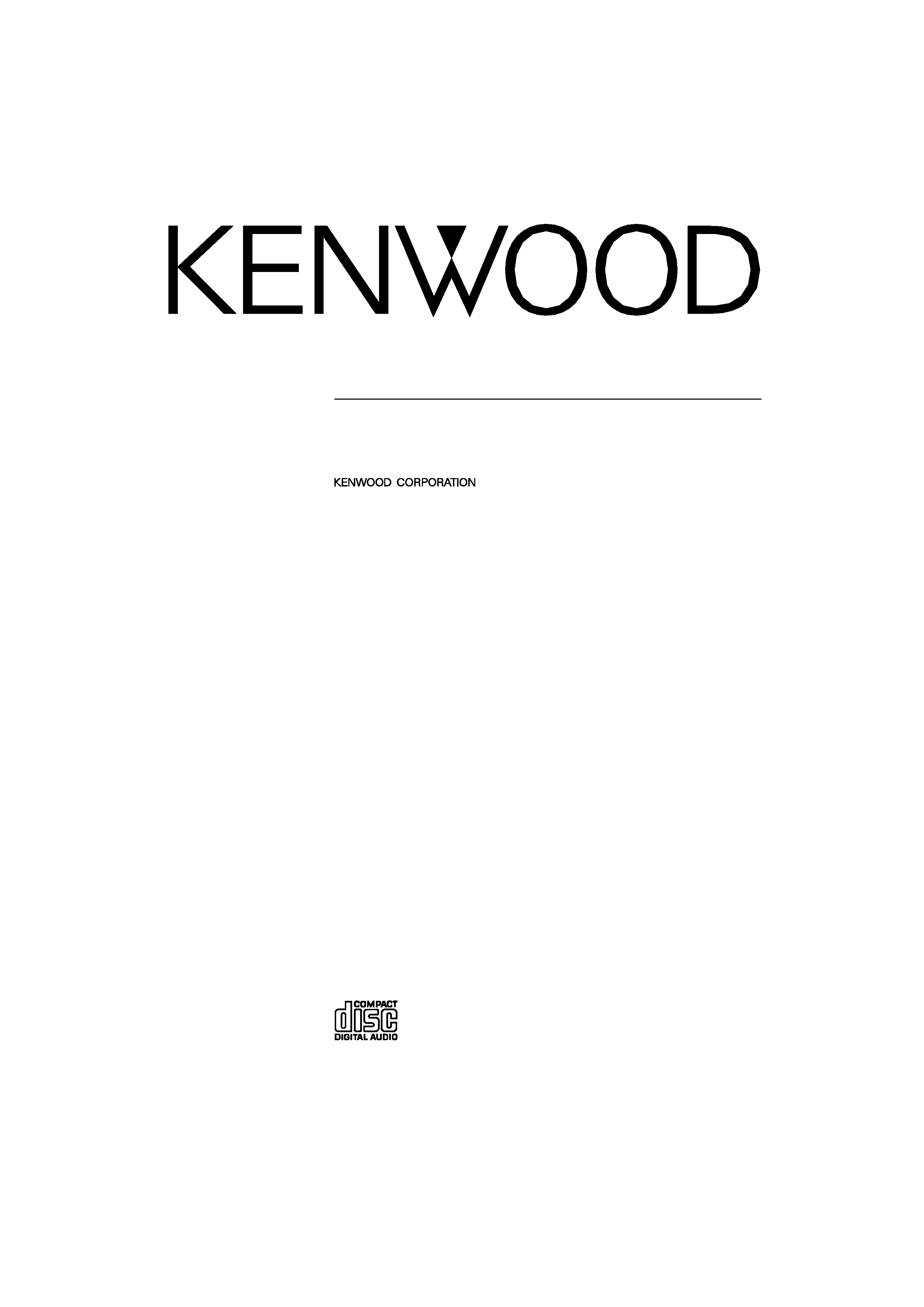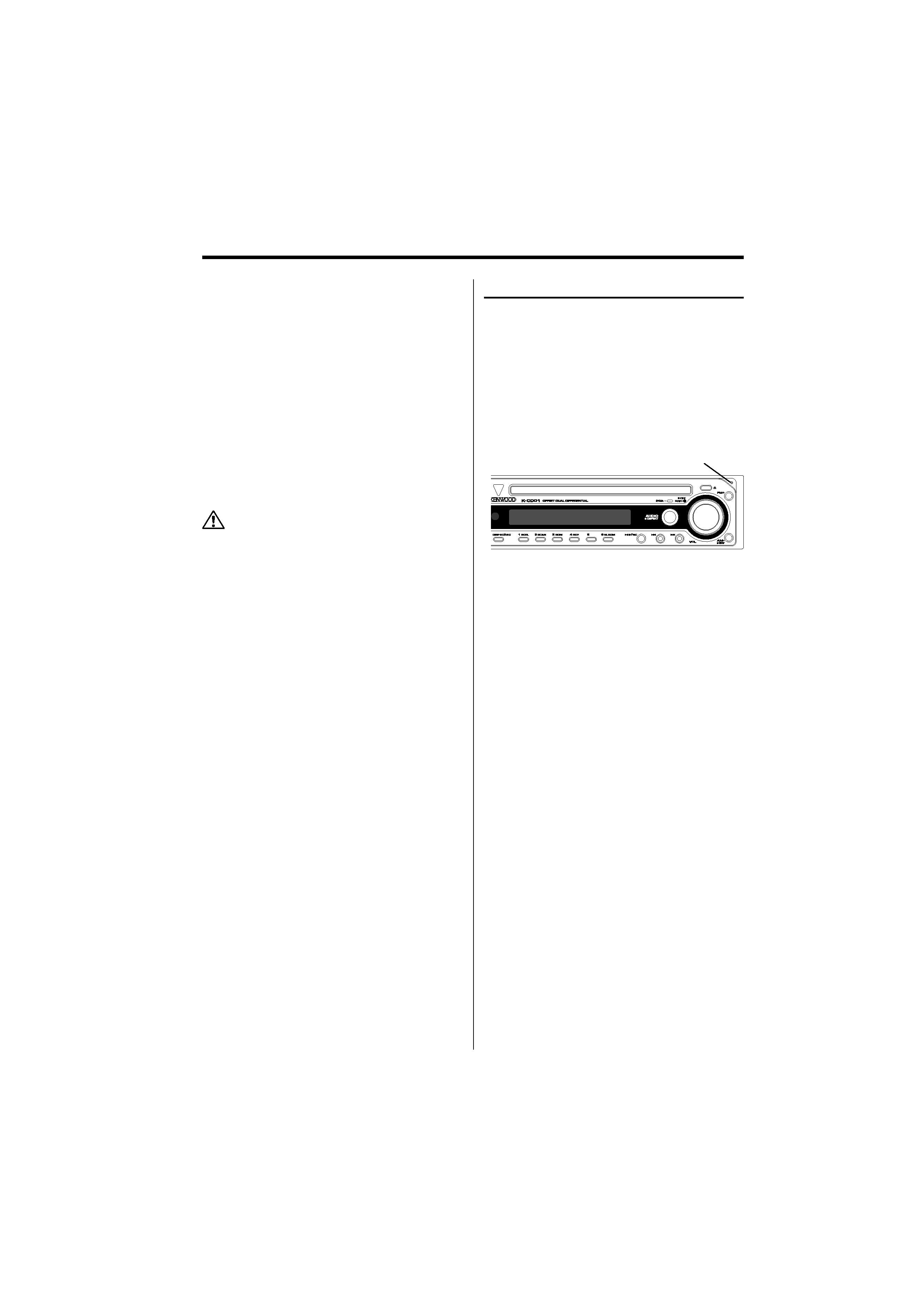
K-CD01
CD-RECEIVER
INSTRUCTION MANUAL
© B64-2923-00/00 (M) (TKR)

2 | English
Contents
Safety precautions
3
WARNING
CAUTION
NOTE
Notes
5
About CDs
6
General features
7
Power
Selecting the Source
Volume
Audio Control
Defeat Setting
Switching Display
Subwoofer Output
Tuner/TV control features
9
Tuning
Direct Access Tuning
Station Preset Memory
Auto Memory Entry
Preset Tuning
CRSC (Clean Reception System Circuit)
Frequency Step Setting
TV Tuning
Preset TV Tuning
TV Preset Memory
Direct TV Tuning
CD/External disc control features 12
Playing CD
Playing External Disc
Fast Forwarding and Reversing
Track Search
Disc Search
Direct Track Search
Direct Disc Search
Track/Disc Repeat
Scan Play
Random Play
Magazine Random Play
Text/Title Scroll
Menu system
15
Function Set
Contrast Adjustment
Selecting display mode
Touch Sensor Tone
Security Code
Built-in Amp Mute Setting
Security Indicator
Manual Clock Adjustment
Tuning Mode
Auto Memory Entry
Text Scroll
B.M.S. (Bass Management System)
B.M.S. Frequency Offset
AMP Control
Basic Operations of remote
19
Accessories/ Installation Procedure 21
Connecting Wires to Terminals
22
Installation
23
Removing the Unit
24
Troubleshooting Guide
25
Specifications
27

English
|
3
Safety precautions
2CAUTION
To prevent damage to the machine, take
the following precautions:
· Make sure to ground the unit to a negative 12V
DC power supply.
· Do not open the top or bottom covers of the unit.
· Do not install the unit in a spot exposed to direct
sunlight or excessive heat or humidity. Also avoid
places with too much dust or the possibility of
water splashing.
· When replacing a fuse, only use a new one with
the prescribed rating. Using a fuse with the wrong
rating may cause your unit to malfunction.
· To prevent a short circuit when replacing a fuse,
first disconnect the wiring harness.
· Do not use your own screws. Use only the screws
provided. If you use the wrong screws, you could
damage the unit.
2WARNING
To prevent injury or fire, take the
following precautions:
· Insert the unit all the way in until it is fully locked
in place. Otherwise it may fall out of place when
jolted.
· When extending the ignition, battery, or ground
wires, make sure to use automotive-grade wires
or other wires with a 0.75mm² (AWG18) or more
to prevent wire deterioration and damage to the
wire coating.
· To prevent a short circuit, never put or leave any
metallic objects (such as coins or metal tools)
inside the unit.
· If the unit starts to emit smoke or strange smells,
turn off the power immediately and consult your
Kenwood dealer.
· Be careful not to drop the unit or subject it to
strong shock.
The unit may break or crack because it contains
glass parts.
· Do not touch the liquid crystal fluid if the LCD
is damaged or broken due to shock. The liquid
crystal fluid may be dangerous to your health or
even fatal.
If the liquid crystal fluid from the LCD contacts
your body or clothing, wash it off with soap
immediately.

4 | English
NOTE
· If you experience problems during installation,
consult your Kenwood dealer.
· If the unit fails to operate properly, press the Reset
button. The unit returns to factory settings when
the Reset button is pressed. If the unit still fails to
operate properly after the Reset button has been
pressed, contact your local KENWOOD dealer for
assistance.
· Press the reset button if the disc auto changer fails
to operate correctly. Normal operation should be
restored.
· Characters in the LCD may become difficult to
read in temperatures below 41 °F (5 °C).
· The illustrations of the display and the panel
appearing in this manual are examples used to
explain more clearly how the controls are used.
Therefore, what appears on the display in the
illustrations may differ from what appears on
the display on the actual equipment, and some
of the illustrations on the display may represent
something impossible in actual operation.
Lens Fogging
Right after you turn on the car heater in cold
weather, dew or condensation may form on
the lens in the CD player of the unit. Called lens
fogging, CDs may be impossible to play. In such
a situation, remove the disc and wait for the
condensation to evaporate. If the unit still does
not operate normally after a while, consult your
Kenwood dealer.
Safety precautions
About CD players/disc changers
connected to this unit
KENWOOD disc changers/ CD players released in
1998 or later can be connected to this unit.
Refer to the catalog or consult your Kenwood
dealer for connectable models of disc changers/
CD players.
Note that any KENWOOD disc changers/ CD players
released in 1997 or earlier and disc changers made
by other makers cannot be connected to this unit.
Unsupported connection may result in damage.
Setting the "O-N" Switch to the "N" position for the
applicable KENWOOD disc changers/ CD players.
The functions that can be used and the information
that can be displayed will differ depending on the
models being connected.
· You can damage both your unit and the CD changer if
you connect them incorrectly.
LX-bus connection
The LX AMP and the sensor unit cannot be
connected simultaneously.
You must connect any of them at a time.
(The power supply does not turn ON if you have
connected both of them.)
Reset button

English
|
5
Notes
Cleaning the Unit
If the faceplate of this unit is stained, wipe it with a
dry soft cloth such as a silicon cloth.
If the faceplate is stained badly, wipe the stain off
with a cloth moistened with neutral cleaner, then
wipe neutral detergent off.
· Applying spray cleaner directly to the unit may affect its
mechanical parts. Wiping the faceplate with a hard cloth
or using a volatile liquid such as thinner or alcohol may
scratch the surface or erases characters.
Cleaning the CD Slot
As dust tends to accumulate in the CD slot, clean it
every once in a while. Your CDs can get scratched if
you put them in a dusty CD slot.
The marking of products using lasers
(Except for some areas)
CLASS 1
LASER PRODUCT
The label is attached to the chassis/case and says
that the component uses laser beams that have
been classified as Class 1. It means that the unit
is utilizing laser beams that are of a weaker class.
There is no danger of hazardous radiation outside
the unit.
